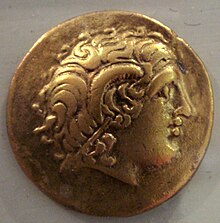Sequaner
The Sequani ( Latin Sequani ) were a Celtic tribe in Gaul . Its main town was Vesontio , today's Besançon . Our knowledge of the Sequans is mainly due to Caesars De Bello Gallico . The Roman province of Maxima Sequanorum (also Sequania , Sequanica or Sequanicum ) was named after this tribe.
history
Originally the Sequaner probably settled in the Seine valley, but later settled in the area between the Saône , Rhone and the Jura mountains . In a dispute with the Haeduern they called in 72 BC The German king Ariovist to help. In 61 BC The Haeduians were defeated in the battle of Magetobriga (La-Moigte-de-Broie), but in return Ariovistus occupied large parts of the Sequaner area. During the Gallic War and Gaius Iulius Caesar's fight against Ariovistus, the Sequani were subjugated (58 BC) and have been under Roman rule ever since . In 52 BC The Sequani fought on the side of the Vercingetorix against Caesar. 21 AD they are involved in the riots of Iulius Sacrovir . In 68 AD they joined the rebellion of Gaius Iulius Vindex , which was put down in the battle of Vesontio by Lucius Verginius Rufus , the legate of the province of Upper Germany .
Others
The saints Ferreolus and Ferrutius, who are still venerated in the city of Besancon, are said to have proselytized the Sequani around 200 AD and suffered their martyrdom .
swell
- Gaius Iulius Caesar : Commentarii de bello Gallico . (Comments on the Gallic War).
- Cassius Dio : Roman History
literature
- Sequani . In: The New Pauly , Volume 11
Web links
Individual evidence
- ↑ a b Lexicon entry on gottwein.de
- ↑ Caesar, De bello Gallico 1,31,3-4.
- ^ Caesar, De bello Gallico 1, 31, 10-13.
- ↑ Cassius Dio 63.23.1-63.24.4.
- ↑ Online editions: Latin – English at perseus.tufts.edu, Latin – German at Wikibooks .

